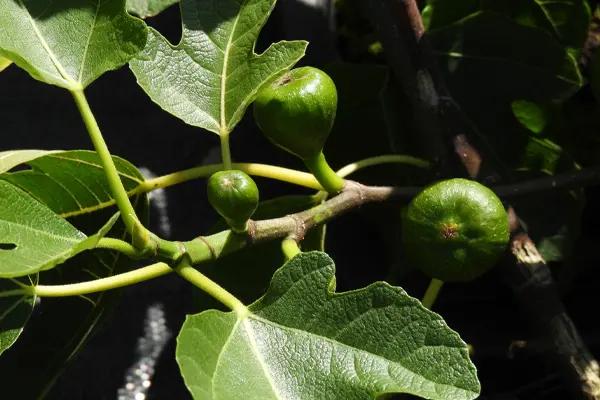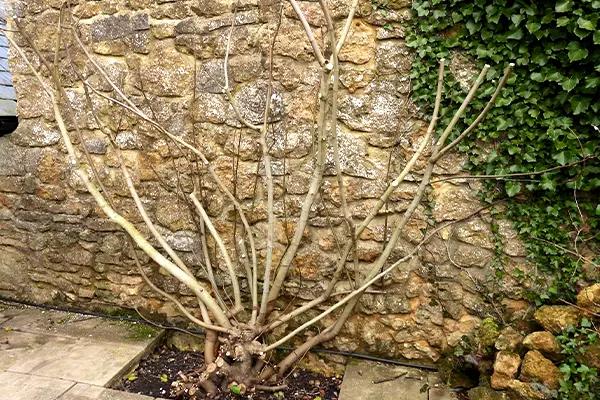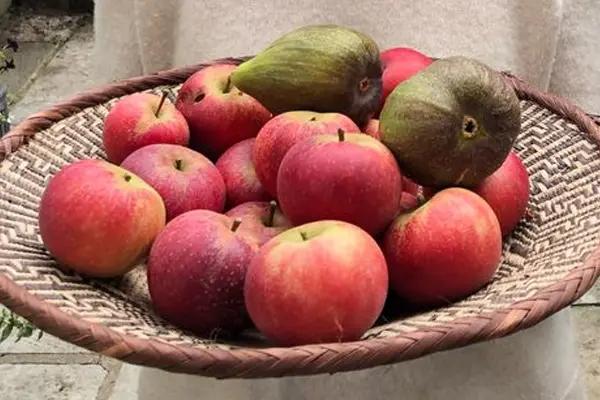The most popular fig variety in the UK for getting fruit from is the ‘Brown Turkey’ fig.
The instructions for ‘Brown Turkey’ apply to other figs, such as the wild species Ficus carica, but those are more commonly grown as ornamental trees.
The dwarf variety, ‘Little Miss Figgy‘, is different: very slow growing and requires little pruning.
Table of Contents
How Figs Fruit
Figs fruit on the previous year’s wood (a bit like summer fruiting raspberries). The tiny fruitlets from the previous autumn begin to grow larger from about the end of March and by late summer they ought to be ready to pick.
Ripening is heat dependent so figs tend to do better planted against a wall or in a sunny corner.

Figs can crop 2 or even 3 times a year in warmer climates than the UK. In long summers, figs that are grown under glass/plastic can repeat crop but the second crop may fail to ripen unless the weather in August is good.
When grown outside in the UK figs only produce a second crop in freak summers.
Don’t be fooled by clearly unripe but more developed fruits on the tree later in the season. These will neither ripen nor last through the winter so it is best to simply take them off.
You can tell when figs are ready for harvesting because:
- Colour changes
- Soft when squeezed
- Sticky juice (nectar) at the bottom of the fruit
- Splits can appear in the skin near the stalk
Pot Grown Figs
You should repot your fig every 3-4 years when it is without leaf, in winter. When the pot is as large as you can cope with continue repotting every 3 years or so by removing about 25% of the rootball. Trim down the sides and remove a bit off the bottom. Then you can repot in the same sized container with fresh compost under and around the remaining (reduced) rootball. The roots will regrow and fresh nutrients will be available to the plant. We recommend John Innes No. 3 compost for this.
Fig trees grown in pots should be fed and watered at regular intervals. Between the time they break into growth and the end of August they should be watered and fed with tomato fertiliser every fortnight. In the middle of this 2 week period, they should be fed and watered with a more balanced fertiliser. So they get fed and watered weekly. During hot spells check the compost and water (but don’t feed) more often if it dries out.
Planting fig trees in open soil
Fig trees grow in any well drained soil.
To get the best crop of figs, you need to restrict the roots of your fig tree. By making a strong barrier around the roots of your tree, you will make it grow to a manageable size and produce more fruit.
Ideal places to grow a fig tree:
- In large containers.
- In between a wall and a path with concrete foundations (a 60cm gap is enough).
- In an expensive wall?

Figs in walls
If you are planting a free-standing tree out in the open, you will need to place stone slabs or pieces of concrete under the soil:
- Dig a hole about 2.5 feet / 75cm square.
- Line the sides with solid pieces of stone (like slate), or slabs of concrete.
- Drive a strong stake into the soil at the base of the hole.
- Line the base of the hole with tightly packed stones: broken up bricks are good. Make a layer about 20cm thick.
You can now plant the fig tree and attach it to the stake while it establishes new roots.
For best results, add plenty of well-rotted manure and compost to the soil that you fill back in to plant your trees.
Planting fig trees against a wall
Fig trees are ideal for growing as a fan shape against sunny, south facing walls.

To get the best crop of figs, you need to restrict the roots of your fig tree.
By making a strong barrier around the roots of your tree, you will make it grow to a manageable size and produce more fruit.
Ideal places to grow a fig tree:
- In large containers.
- In between a wall and a path with concrete foundations (a 60cm gap is enough).
- In a prepared box below the soil, as described below:
| Size of Wall to Cover | Size of Hole to Dig |
| 8 feet high by 15 feet wide | 6 feet long, 2 feet deep, 2 feet wide |
| 6 feet high by 10-12 feet wide | 2 feet square |
- Dig the appropriate size of hole.
- Line the sides with solid pieces of stone (like slate), or slabs of concrete.
- Line the base of the hole with tightly packed stones: broken up bricks are good. Make a layer about 20cm thick.
For best results, add plenty of well-rotted manure and compost to the soil that you fill back in to plant your trees.
Pruning a Fig Tree
This pruning guide was written specifically for Brown Turkey fig trees, but it applies to most of the other varieties of Ficus carica grown in the UK, except the dwarf variety, Little Miss Figgy, which grows slowly and so needs very little pruning.
It’s best to prune your fig trees in the spring. In the video below, you’ll be shown how to reduce the height, take out unwanted crossing branches and generally tidy up the look of your fig tree.
You will need some secateurs and a pruning saw, and/or some bypass loppers.
Ross Raddi takes you through the complete life story of your fig, from a small plant up to a productive tree.
To maximise crop size, freestanding and pot grown figs are best grown as bushes and their early pruning is therefore along the same lines as that of a young apple tree. They grow faster than apples, so the pruning stages can be compressed into a shorter time period.
Your objective is to create an open, goblet-shaped head. This basic framework lets air and light into the fruiting areas of the tree.
There are three main “prunings” your fig will need – in March, May and June. Put them in the diary!
- February: (delay until March in the North) Cut out rubbing, crossing and damaged branches as well as any that get in the way of your “goblet” head. You can also cut long, fruitlet-less branches back very hard (to about 2-3”). Not too many, though; you do not want to kill the poor tree. It is a good idea to deal with suckers at the same time. Try to tear them off the root from which they have grown rather than cut them.
- Late May: there should be a fair bit of new growth on the tree now. If not, wait a couple of weeks. Prune all these new branches back to 5 or 6 leaves.
- End of June: You can deal with any laggards the same way at the end of June. No more pruning this year, please….
The fourth of the three prunings is not a pruning, but in:
- Early September: pick off the larger unripe figs – they will never be edible now. Take care to leave as many of the little fruitlets (they should be about the size of a decent garden pea) as possible.
Renovating an old fig tree
Without the regular pruning outlined above, figs have a tendency to produce long, relatively leafless and fruitless branches. The fruit only ripens on last year’s wood, so what fruit you get will be at the end of long bare stems.
So:
- In February in the South and March in the North, prune out about 25% of the worst/barest/oldest branches down to 2-3″ from the main trunk.
- This will cause new growth during the summer. If the tree is overcrowded, and you do not want so much new wood, then prune some branches right back to the trunk.
- In about July, with the framework of the tree in mind, keep the best new growth and cut out the rest flush with the trunk.
How to Harvest Figs in Britain
In the British climate, your fig trees will try to make two batches of fruit per year. However, only the later batch will be able to ripen.

- In late Autumn, you will see small, hard little green figs (like big peas) growing on wood that is over a year old.
- If you are growing your trees in the open, you need to protect these baby figs from frost during the winter by wrapping them up well in straw.
- These will ripen the following year and be ready to pick in August-September.
Each year, you will also get little figs appearing during summer on wood that is less than a year old. These will not be able to ripen, and you should pick them off to save the tree’s energy for the later crop.
When to Harvest your Figs: A ripe fig is soft and droops down from the branch. Very ripe fruit is prone to splitting and will sometimes produce drops of sweet nectar – these need eating right away.
Storing Figs: Figs should be eaten fresh, but you can store them for about two weeks in a cool, dry place – do not put them in the fridge.
